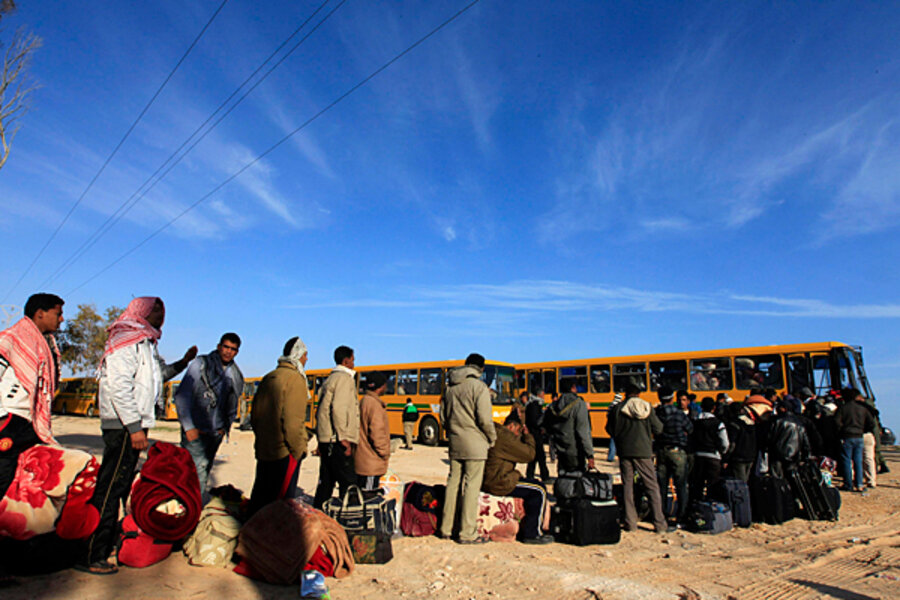Libya crisis: neighbors brace as tide of refugees rises
Loading...
| Cairo
More than 110,000 refugees have fled Libya in the last week, pouring across the borders in a swelling tide that threatens to burden Libya’s neighbors, who are struggling to absorb the influx or worried about doing so as fighting intensifies.
Most of those fleeing Libya are foreign workers, the majority of them Egyptian, whose jobs are now gone or who felt too unsafe to stay. There are about 1.5 million Egyptians alone who work in Libya, according to the UNHCR. Their flight could further harm Egypt’s struggling economy as their families in Egypt lose the remittances they depended on.
Nearly 50,000 people have crossed Libya’s eastern border into Egypt, but the real crisis is on the western border with Tunisia, where refugees keep arriving. Tens of thousands are waiting on the Tunisian border for transport home, while thousands more are still spilling across every hour.
“If there is not a large-scale movement … then you’re going to have a humanitarian situation that’s going to degenerate pretty quickly,” says Tirana Hassan of Human Rights Watch, who is in the Tunisian border town of Ras Ajdir. “They’re moving them [out] by the hundreds, but they’re coming in by the thousands. It’s a bit like sand in an hourglass, really – they’re just moving from one side to another.”
Transitional camps overflowing
The Tunisian authorities, UNHCR, and the International Organization for Migration are working to facilitate the repatriation of the refugees and care for those stuck in Tunisia, but Ms. Hassan says the transitional camp set up near the border, with a capacity of 3,000-4,000 people, is already overflowing. The flow of people across the border had not abated Monday, she said, and refugees said that more people were on their way.
“It’s becoming very difficult for the authorities to actually absorb the number of people coming across at this time. The numbers are certainly swelling,” says Hassan. “The logistical challenge is enormous. It’s relentless at this stage.”
The overwhelming desire of the refugees is to return to their homes, but getting them there is difficult. Some Egyptians are being taken by bus to the coast, where ships are supposed to transport them back to Egypt, while other refugees are being taken by air. There are some from Bangladesh and other nations who have no government assistance at the border and are essentially stranded. Others have no travel documents.
The movement is simply too slow, according to aid workers. UNHCR High Commissioner for Refugees, António Guterre, in a statement Monday urged neighboring nations to keep their borders open and accept refugees “without discrimination.”
Hassan says the local community of Tunisians is stepping forward to help the refugees as resources are strained. Some are taking in people, putting them up in community centers, while others are acting as chauffeurs, driving people between the border and the camp.
“Their generosity is exceptional, but how long can it last?” she asked, adding that tensions are growing as the community struggles to absorb the influx.
On Monday, she said it appeared the Tunisian authorities were making greater attempts to bring more organization to the border, centralizing aid distribution and even bringing in police in riot gear to handle crowds that could grow difficult at times.
Most of those fleeing had not been exposed to violence, but were afraid of it. “Families said they had been locked in their houses for days, afraid to go out,” she says. “The days were calm but at night they heard gunfire.” She said she had also received reports that a group of Egyptians who had gathered at Tripoli’s airport had been violently dispersed by police, who used cattle prods and batons against them, and that some were killed.
Egyptian border operation running more smoothly
On the Egyptian border at Sallum, where 46,000 people have crossed in the last week, the process is smoother. Egyptian authorities have designated 195 buses to transport the refugees, mostly Egyptians, from the border to their cities, says Elizabeth Tan, deputy representative of the UNHCR in Cairo. Egypt is also allowing Libyans to enter Egypt freely and is giving them transportation to their desired destinations. So far, 2,100 have crossed the border, says Ms. Tan.
“The government has given assurances that any Libyan who crosses will be welcomed; it doesn't matter how many. At the moment of course the numbers are small, but if the situation deteriorates in eastern Libya, there may be more,” she says.
About 10,000 non-Egyptian and non-Libyan refugees have crossed the border, the majority of whom are Bangladeshi. The UNHCR is providing blankets, water, and food to those who have to wait at the border, and is erecting tents for those who have to spend the night. Most of the people leaving Libya are single men, says Tan, though there are some families.
Though the situation on Egypt’s border may be less critical than the one in Tunisia, it’s still a major effort. “It’s stretched, I wouldn't say that it's comfortable,” says Tan. “It's well-organized, and food is being provided, but still its a large influx of people.... I wouldn't say it’s a humanitarian emergency as such, but still large numbers of people and people who are really very scared.”
The organization is also worried about the thousands of African refugees and asylum seekers trapped inside Libya who want to leave but cannot because they fear being mistaken for the mercenaries hired by Quaddafi’s security forces to attack protesters.
“Many of them are from countries like Somalia, Eritrea, Ethiopia. None of them have reached the borders on this side,” she said. “We've received calls from them, and many of them have been too afraid to move out of their homes.”





